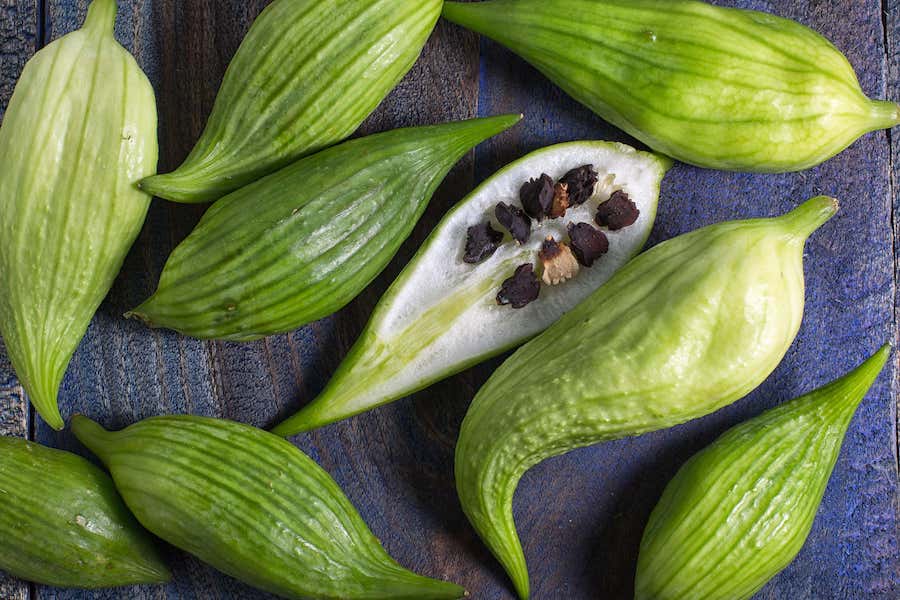Alternative vegetabkes to grow for next season
Egyptian walking onions and Chinese artichokes could be on the menu
Planning which veg to grow next season and want to have a go with something a bit different?
Egyptian walking onions, Chinese artichokes and Malabar spinach are just a few of the diverse plants you could grow, according to sustainable growing experts at Garden Organic .
The charity is on a mission to show the range of foods which can be successfully grown in British gardens and will thrive in our changeable climate.
Garden Organic’s head gardener, Emma O’Neill, says: “From Malabar spinach, a vine plant that will keep on giving, to luffas, which can be eaten or used as a sponge, to onions that parade around your plot, they can all thrive in your garden.”
She suggests having a go with the following unusual vegetables.
1. Egyptian walking onions
View this post on Instagram
Egyptian onions are often given the name of ‘walking onions’ as this perennial crop can literally walk its way round your plot.
Each plant should give you two crops a year. In spring you will get fresh greens like spring onions. If you leave some of the shoots they will form bulbils at the top. The stems will then collapse and the bulbils will fling themselves into the soil nearby and plant themselves – hence the name walking onions.
The bulbils can then be harvested as a small onion. Leave some in the ground to grow again next year.
Growing advice
1. Plant from late summer until the first frost.
2. Plant onion bulbs in a well-drained soil about 5cm deep, with 15-25 cm between each bulb, if you like large pungent onions. If you prefer a steady harvest of green, milder onions, or if you want to use the stalks like chives, plant the bulbs 5-8cm apart.
3. Keep the soil lightly moist.
2. Chinese artichokes
View this post on Instagram
These perennial frost-hardy tubers can be planted out any time from October to April. They produce segmented tubers two to three inches long which have a great nutty taste and are wonderful in a stir-fry or salad. In Japan they are commonly pickled. Chinese artichokes are in the mint family, so they produce slightly hairy, large mint like leaves.
Growing advice
1. Plant in moist light soil 20cm apart and 5cm deep.
2. Plant between October and April before the tubers start sprouting.
3. Harvest in autumn and leave some in the ground to come back next year.
4. Every few years, dig them all up and move to another spot (but you will probably find you can never get rid of all of them).
3. Luffa
View this post on Instagram
Luffas are tender vines that can be easily grown indoors or outside in a very sheltered position. They have fruits that are edible when young and green, developing a fibrous structure when mature which can be used like a sponge – great to help cut down on plastics in the bathroom.
Growing advice
1. Start luffa seeds off indoors in April-May, two to three seeds to a 12cm pot and remove the weaker seedlings. Germination rates can be low, so sow more than you need.
2. Move on to larger pots if required before hardening off and planting out in early June.
3. If growing in containers, a 30cm/12in pot is fine for a single plant. Alternatively, you could plant two in a growing bag.
4. If planting in open ground, luffas need a sunny, well-drained spot sheltered from strong winds.
5. The plants will require support. Stout trellis or a chain-link fence is better than bamboo poles, as they will twine but don’t climb well unless tied in regularly.
6. Luffas aren’t very demanding in their soil requirements, and don’t need as rich a soil as other cucurbits, but once flowers appear weekly feeding with comfrey liquid can improve the fruiting.
4. Malabar spinach

Malabar spinach
Malabar spinach can be eaten raw in salad or the leaves cooked as spinach. The plant is an attractive and quick-growing vine with glossy leaves and red-tinged stems.
As summers become hotter due to climate change, this plant – ideally grown indoors – is a great option as it doesn’t bolt in hot weather like normal spinach and takes up very little space as it grows vertically.
Growing advice
1. Sow from seed or from cuttings (5-6 inches) mid-March-May. They should start growing in two weeks’ time. Two plants will serve you well as you can harvest constantly.
2. Grow indoors or under glass.
3. Erect trellis to support the vine.
5. Achocha
View this post on Instagram
Achocha is described as ‘One of the Lost Crops of the Incas’ and some have wondered, how, as it can be rampant. The small, cucumber-like fruits have a fresh flavour, a cross between a minty cucumber and a green pepper. They can be eaten raw or stir-fried when young; when mature they have tougher skins so stuff with meat, fish or cheese, and then bake. They can also be pickled or used as a base for chutney.
Growing advice
1. Sow seeds into pots under glass or on the windowsill in April/May and set them out when all danger of frost has passed, or grow under glass. They prefer warmth (rather than heat) and humidity.
2. Support them, preferably with netting which their tendrils can grip. They won’t cross-pollinate with cucumbers or squashes and are self-fertile.
For more information on organic and sustainable gardening, visit gardenorganic.org.uk
The Press Association
Latest posts by The Press Association (see all)
- BBC to air two-part Call The Midwife Christmas special - December 23, 2024
- 6 mind sports to exercise your brain and keep you sharp - December 20, 2024
- Quiz: What classic Christmas food or drink are you? - December 20, 2024
- Leftover turkey and watercress pie - December 20, 2024
- Catherine and William choose family shot for Christmas card photograph - December 19, 2024




















